We hope that each of you, our readers, will enjoy and appreciate this article we present about these 5 Magnificent Mammals of Greenland. It was our pleasure to gather the information for you. May it provide you with both education and increased awareness.
Certainly, these few species listed herein represent only a portion of the similar marvels in this region. It’s our belief, though, that they serve as excellent representations of the wonders that exist here. Check out some of our other articles for similar marvels.
Arctic Fox
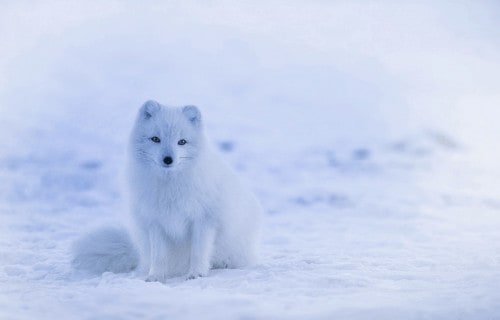
Arctic Fox Facts
- Starting off this article about 5 Magnificent Mammals of Greenland we present the beautiful wild canine known as the Arctic Fox.
- This magnificent mammal most frequently goes by the descriptive and informative common name due to its range. The animal has several other general names, though. These include the titles of polar fox, snow fox, and the fully appropriate white fox.
- Within scientific circles, however, it’s better known by its technical name. Fortunately for the average layperson, that’s a relatively simple term, as such things go. That’s because this beautiful wild canine holds the short scientific name of Vulpes lagopus.
- It received that easy to pronounce name due to the efforts of the renowned Swedish zoologist, Carl Linnaeus. He achieved the first recorded acknowledgement of it as a separate and distinct species. He managed this scientifically noteworthy deed in 1758.
- It’s also renowned for several reasons. One is, of course, its sheer beauty. Another distinction it holds is the fact that it’s the only land mammal endemic to the country of Iceland. Four known subspecies of this wonder of Nature also currently exist.
- Despite the extreme harshness of its native habitat, the Arctic Fox seems to be in relatively good shape as a species. The stunning mammal appears to have a population base that’s both sufficient and stable. The IUCN thus presently lists it as Least Concern.
- Nevertheless, it must be considered to be facing at least some threats to its continued existence. Despite being legally protected in parts of its range, illegal hunting of it persists. It also now faces the same threat of ongoing climate change as all species do.
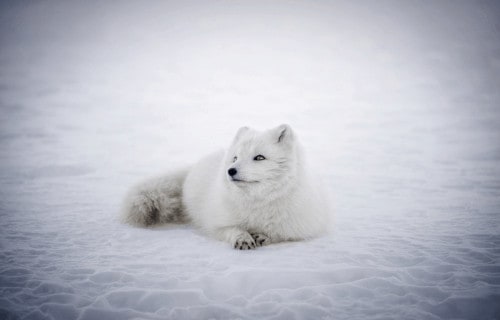
Arctic Fox Physical Description
The stunning Arctic Fox clearly impresses those fortunate to encounter one in the wild. That’s when they can even see it, given its incredible camouflage. The animal achieves that impression due more to its remarkable appearance than its sheer physical size.
That’s because, despite its other wondrous attributes, it’s only an average-sized variety of fox. It also follows another pattern common to its relatives. That’s true since this amazing animal displays the physiological characteristic known as sexual dimorphism.
In its case, this trait manifests itself in terms of pure physical size. More specifically, males attain a larger average body size than their female counterparts. That difference, however, ranks as comparatively minor. Otherwise, the two genders remain virtually indistinguishable.
The males of the species reach an average head-and-body length of approximately 22 in (55 cm). Exceptional specimens sometimes reach 27 in (68 cm). Females, meanwhile, grow to an average length equaling roughly 20 in (52 cm), excluding the tail, of course.
In both sexes of the Arctic Fox, the tail develops as relatively long. This appendage reaches an average length of 12 in (30 cm). The animal also grows to 9.8 – 11.8 in (25 – 30 cm) at the shoulder. Males average 7.7 lb (3.5 kg), while females average 6.4 lb (2.9 kg).
Yet its the mesmerizing coloring of the animal that garners the most attention. Although the young display dark colors, this changes quickly to a dazzling white as they mature. This shade covers the entirety of the body, all the way to the tip of the fluffy tail.
- Kingdom: Animalia
- Phylum: Chordata
- Class: Mammalia
- Order: Carnivora
- Family: Canidae
- Genus: Vulpes
- Species: V. lagopus

Arctic Fox Distribution, Habitat, and Ecology
The beautiful Arctic Fox evolved as native to a surprisingly large region of the world. As its very name implies, this includes the Arctic Circle. But it’s not restricted to that area, though. It appears in the more northern portions of Europe, Asia, and North America.
That range even includes such isolated areas as Iceland, Greenland, Svalbard, and other islands located in the Barents Sea. In Canada, it appears as far south as Hudson Bay. The animal was also previously introduced to the Aleutian Islands southwest of Alaska.
Its habitat consists almost exclusively of regions of Arctic tundra. It also favors sections of pack ice. The animal does manage to survive in a few other habitats, though. These mainly include boreal forests in such places as the Kenai Peninsula and several in Canada.
Within this type of environment, it also appears at a surprising range of altitudes. Many individuals live in regions of up to 9,800 ft (3,000 m) above sea level. Other specimens, though, have been spotted on collections of sea ice very close to the North Pole itself.
Protected by its warm, dense fur, the Arctic Fox evolved as a pure predator. It feeds opportunistically, consuming virtually any prey it finds. This prey typically includes such species as voles, lemmings, birds, hares, eggs, small fish, and even carrion when available.
Intriguingly, it has few natural predators itself, despite its relatively small size. The few creatures that do routinely prey on it include wolves, bears, and golden eagles in some parts of its range. In the wild, few live even one year, but some live as long as 11 years.
Walrus
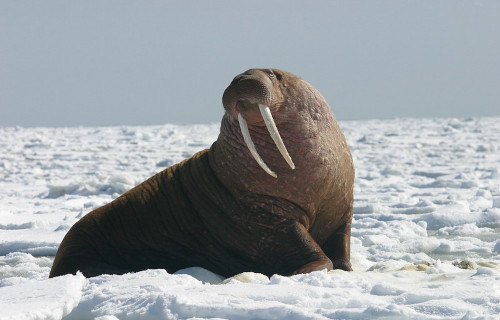
Walrus Facts
- Next up in this compendium of 5 Magnificent Mammals of Greenland comes the impressive creature known simply as the Walrus.
- This massive product of Nature and evolution most frequently goes by the short common name used here across its range. It currently has no other broadly accepted general name. Though certain not unknown, that’s nonetheless somewhat uncommon.
- It’s the only surviving member of its Family. The appellation holds yet another unusual status. That’s because of the fact that the same term also applies to two separate recognized subspecies. Those consist of the Atlantic Walrus and the Pacific Walrus.
- Among scientific professionals, however, a different moniker typically applies. That’s true since its technical title generally predominates in such situations. Unfortunately for the layperson, though, that’s the hard to pronouce epithet Odobenus rosmarus.
- The creature received that designation due to the efforts of Carl Linnaeus. The highly esteemed Swedish zoologist accomplished the first recognition of it as a separate and distinct species, originally. That noteworthy deed occurred in 1758.
- Sadly, the amazing Walrus presently finds itself in somewhat dire straits. Its population suffered drastically in the past, due to human activities. Though it enjoys protected status now, the species is still suffering the effects of prolonged hunting practices.
- Now, however, it also faces other threats to its continued existence. Give its precarious situation, the IUCN currently lists it as Vulnerable on its Red List. The major dangers it faces consist of the related troubles of habitat loss and ongoing climate change.
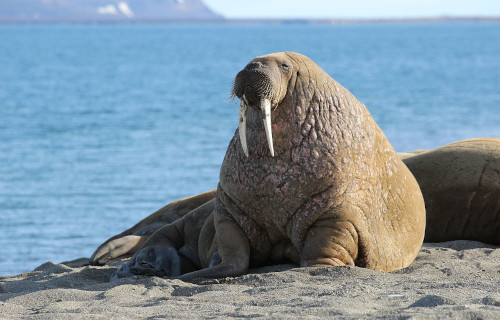
Walrus Physical Description
The magnificent Walrus is a work of Nature that fully merits the respect and appreciation it typically receives from those who view it. The pinniped does so, however, due to more than its unique appearance. That’s true since it’s also a highly impressive-sized animal.
It also shares a trait common to many, if not most, animals. That’s the fact that it displays a certain degree of the physiological characteristic of sexual dimorphism. Though this varies between the two subspecies, generally speaking, females show different size and color.
On average, the Pacific subspecies attains the greater dimensions of the two. In this subspecies, as well as the other, males reach larger average sizes than their female counterparts. These measure an average of 18% longer and 45% heavier than the females.
Males of the larger subgroup typically achieve truly impressive stature. In fact, they rank as the third largest of all pinnipeds. A mean body length equals roughly 9 – 12 ft (2.7 – 3.6 m). Meanwhile, weights generally range from 1,764 – 3,748 lb (800 – 1,700 kg).
Females of the subgroup develop as slimmer in structure, as the percentages indicate. Their overall length usually measures between 7.5 – 10 ft (2.3 – 3.1 m). Masses for them, though, generally range from 882 -2,756 lb (400 – 1,250 kg). Exceptions do occur, however.
The genders of both subdivisions of the amazing Walrus also show differences in terms of color patterns. Overall, this tends to consist of a cinnamon-brown shade. Yet, differences nevertheless appear. Males most often display a slightly lighter hue than females.
Other differences also present themselves to distinguish the two sexes. In addition to be lighter colored, the skin of males usually develops as thicker and less hairy than females. The powerful males also possess significantly longer and thicker tusks than their counterparts.
- Kingdom: Animalia
- Phylum: Chordata
- Class: Mammalia
- Order: Carnivora
- Family: Odobenidae
- Genus: Odobenus
- Species: O. rosmarus
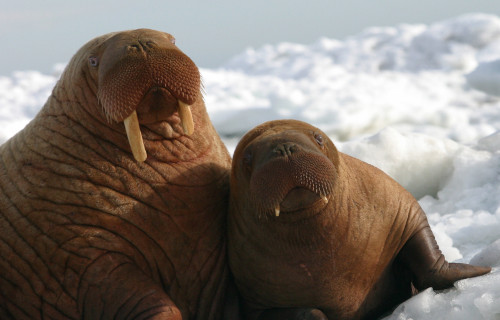
Walrus Distribution, Habitat, and Ecology
Both subspecies of the intriguing Walrus evolved as native to a very specific portion of the globe. As a greater principle, this consists of a moderately large expanse of the earth’s surface. The location of that zone of habitation likely won’t surprise many readers, though.
The two groups developed as endemic to part of the Arctic Ocean region. The Pacific walrus primarily lives north of the Bering Strait in summer, including the regions near such places as northern Alaska. In spring and fall they move to the western area of that range.
The Atlantic walrus, with its much smaller population, though, lives in a different section of the region. That territory extends roughly from the Arctic parts of Canada, to the western part of Russia. That includes such areas as Grenland and the archipelago of Svalbard.
The marvelous mammal displays decidedly strong preferences regarding its choice of habitat. Due to that, the creature shallow shelf regions along the shoreline. Though capable of diving to depths of as much as 1,640 ft (500 m), it usually remains in shallower waters.
Like its may relatives, the Walrus also evolved as carnivorous in nature. The animal consumes a wide variety of locally available species. It also feeds opportunistically. Nonetheless, the natural wonder does display a preference for mollusks, especially clams.
Given its great size, power, and sharp tusks, this carnivore itself has very few natural predators. In fact, only two known species prey on it, and even then only rarely. These consists of the Orca and the Polar Bear. Even these generally only attack the young calves.
Reindeer
Reindeer Facts
- Our next choice for inclusion in this gathering of 5 Magnificent Mammals of Greenland is the unforgettable marvel known as the Reindeer.
- Perhaps most notably, the surprisingly common name applies to a specific variety of deer with a total of 15 subspecies. All of these live as native to specific, and rather harsh, sections of the world. In some ways, this aids in their survival, however.
- The same awesome animal also goes by the name of caribou in parts of its native range, though. Regardless of the name one uses for the impressive creature, however, Indigenous Peoples in parts of its range depend on it for their very survival.
- In addition to the simple facts of its great beauty, one very special fact sets this remarkable creature apart from all other known animals. This characteristic actually formed as a unique adaptation to the climate in which the species evolved.
- Quite amazingly, the beautiful reindeer remains the only known mammal to possess the ability to see in ultraviolet light. Though still numerous, the population of this amazingly adapted mammal unfortunately appears to be in decline.
- The main reason for this seems to be climate change, much like many species around the world today. However, several other factors also threaten the magnificent animal. These include two separate parasites that threaten several local populations.
Reindeer Physical Description
The remarkable Reindeer holds more surprises, in this case in terms of its appearance. That’s because the color of the fur of the mammal varies widely, both in individuals and with the season. This represents yet another uncommon trait that the creature displays.
In point of fact, the coloring generally ranges from off-white to a dark brown. The fur further sometimes develops a most striking mottled pattern. In other aspects of its physiology, though, it displays many of the same traits that characterize many types of animals.
That’s due to the fact that it displays a mild degree of sexual dimorphism. That’s because, in its case, contrary to popularly held belief, both sexes develop antlers. This also sets it apart from related species, because it’s the only species whose females grow antlers.
Those of the mature female, however, generally develop as much smaller than those of the males. Yet overall, the antlers of this beautiful ruminant average up to 39 in (100 cm) in length. These features also attain an impressive average of 53 in (135 cm) in total width.
Mature male Reindeer grow larger than the females and average roughly 7 ft (2.13 m) in length, and weigh an average of 400 lb (182 kg). A few rare males attain a weight of up to 700 lb (318 kg). Typically, an adult also stands about 59 in (150 cm) tall at the shoulder.
- Kingdom: Animalia
- Phylum: Chordata
- Class: Mammalia
- Order: Artiodactyla
- Family: Cervidae
- Genus: Rangifer
- Species: R. tarandus
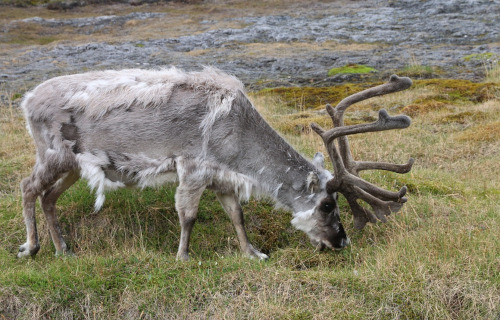
Reindeer Distribution, Habitat, and Ecology
The powerful and majestic Reindeer actually evolved as native to a most surprising part of the world. More precisely, the ruminant remains native to the Arctic and subarctic regions of the world. The impressive animal also migrates within its region of habitation.
This includes much of the tundra regions of the Northern Hemisphere. This range once extended much further south than it does today. Its range also naturally affects its diet. Being a large ruminant, the Reindeer primarily feeds upon a wide variety of local native plants.
These, however, most commonly include such plants as reindeer moss, grasses, sedges. Individuals also consume the leaves of willows and birches. It also feeds on lichen, as well. This further makes it the only known large mammal able to consume lichen.
Despite its relatively large size, it in turn falls prey to a number of predators. These vary, depending upon the region of the world it inhabits. Animals such as golden eagles and wolverines prey on the young. Only polar bears and brown bears feed on mature individuals.
North Atlantic Right Whale
North Atlantic Right Whale Facts
- The next species appearing in this listing of 5 Magnificent Mammals of Greenland is the marine wonder named the North Atlantic Right Whale.
- This majestic marine mammal is most typically referred to by the informative common name that we’ve chosen to use here. Yet, it does have other general titles. These include such terms as black right whale, bone whale, and Biscay whale, among others.
- Scientific professionals, however, perhaps know it better by its technical designation. Unfortunately, though, as often occurs, that’s a somewhat difficult tag for the layperson to pronounce. That’s because it holds the formal epithet of Eubalaena glacialis.
- The magnificent creature received that appellation due to the efforts of Otto Friedrich Müller. The Danish naturalist accomplished the first recognition of it as a separate and distinct species. He managed that scientifically noteoworthy deed in 1776.
- The animal currently represents one of only three recognized species within its genus. Previously, however, scientists classified all three as a single species. This marvel of Nature is now a protected species across much of their native habitat range.
- Sadly, though, the amazing North Atlantic Right Whale finds itself in a most precarious position. Though it’s now protected, humans once hunted it nearly to the point of extinction. It still has a very small population, and recovery proceeds slowly.
- Due to these factors, the IUCN currently lists it as Critically Endangered. The whale faces multiple threats to its continued existence as a species. Most of these stem from the actions of man. They include the dangers of habitat loss and climate change.
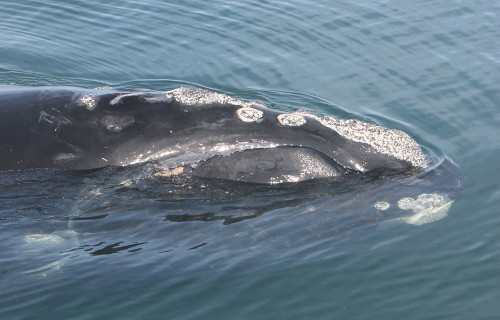
North Atlantic Right Whale Physical Description
The beautiful North Atlantic Right Whale certainly captures the attention of those who encounter it. Like its cousins, it also does so for a variety of reasons. That’s due to the fact that, as with many cetaceans, it possess both great beauty and impressive dimensions.
It also follows another pattern typical to its many relatives. That’s the fact that it displays a certain amount of the physiological characteristic of sexual dimorphism. In this species, that trait manifests itself purely in terms of size. Females are slightly larger than the males.
The gender-based difference remains comparatively minor, though. Overall, mature individuals reach an average length measuring approximately 43 – 52 ft (13 – 16 m). Weights often vary significantly, however, ranging from 88,185 – 154,324 lb (40,000 – 70,000 kg).
Exceptional specimens nevertheless do sometimes occur, regardless of gender. The most physically impressive examples ever reliably confirmed attained lengths of 61 ft (18.6 m), and weighed roughly 234,000 lb (106,000 kg). Such examples remain rare, though.
Other than size, both sexes of the North Atlantic Right Whale present the same appearance. Its most distinguishing attribute, setting it apart from other cetaceans, is its lack of a dorsal fin on its back. It also has a large head that accounts for a large part of its length.
Exact patterns of coloring additionally vary between individuals, though within certain ranges. These primarily consist of various shades or black or gray. A few individuals, however, also display random patches of white, usually on their throats and stomachs.
- Kingdom: Animalia
- Phylum: Chordata
- Class: Mammalia
- Order: Artiodactyla
- Family: Balaenidae
- Genus: Eubalaena
- Species: E. glacialis
North Atlantic Right Whale Distribution, Habitat, and Ecology
The gorgeous North Atlantic Right Whale evolved as native to only a moderate expanse of the marine regions of the earth. Its very name provides the location of that zone of habitation. It developed as endemic to the northern areas of the Atlantic Ocean.
To the north, that extends as far as the Labrador Sea, near Greenland, as well as other regions at the same longitude. To the south that only reaches to Florida, in the United States, in the southeast. It also extends to around the northwest coast of South America.
The remarkable cetacean also evolved decidedly clear preferences regarding its choice of habitat. Yet, the nature of this favoritism drastically limits its available range. This marvel of evolution primarily, but not solely, chooses to reside in waters along the continental shelf.
Individuals and groups nevertheless do occasionally venture far out to sea, into areas of very deep water. The species also migrates seasonally within this greater territory, generally between feeding grounds. This occurs both as individuals and in groups.
The amazing North Atlantic Right Whale, as its many kin around the world, evolved as carnivorous in nature. Its diet consists primarily of copious quantities of relatively small crustaceans and other invertebrates. These include pteropods, krill, and similar creatures.
Following mating, females carry the young for about 1 year. The mother typically nurses young for 1 – 2 years. Even after that, though, calves often stay with or near the mother until around the age of 10. Minus human interaction, an averae lifespan equals about 100 years.
Harp Seal
Harp Seal Facts
- Closing out this compilation of 5 Magnificent Mammals of Greenland comes the beautiful pinniped named the Harp Seal.
- A marvel of Nature and evolution, this majestic creature nevertheless still most frequently goes by this simple common name. It does have a few other, less often used titles, though. Those include the terms Greenland Seal and Saddleback Seal.
- Among scientific professionals, though, it’s more typically referred to by its formal name. That moniker, however, is extremely difficult for the layperson to pronounce. That’s true given that its official title is that of the Pagophilus groenlandicus.
- The remarkable Pinniped received that tongue-twisting appelation due to the efforts of the German naturalist, Johann Christian Polycarp Erxleben. The noted researcher accomplished the first official recognition of it as a separate and distinct species in 1777.
- This impressive masterpiece of Nature classifies as an earless seal, otherwise known as a true seal. It also stands out for a surprising reason. That’s because this distinctive species of seal currently represents the only known member of its entire genus.
- Thankfully, however, the population base of the Harp Seal appears to have rebounded from the past, when it was hunted without restriction. It now has relatively stable and sizeable numbers. The IUCN thus lists the mammal as Least Concern on its Red List.
- The amazing animal nevertheless still faces various threats to its continued existence as a species. This natually includes ongoing hunting practices. Yet it also must deal with the dual dangers posed by habitat loss and the ongoing effects of climate change.
Harp Seal Physical Description
The stunning Harp Seal remain one of those fauna that captures your attention when you encounter it. Unlike some species around the world, however, it does so for more than just one reason. This holds true due to the fact that it’s both beautiful and relatively sizeable.
Like the majority of its kin, though, it also displays a certain degree of the physiological characteristic of sexual dimorphism. In its specific case, however, the animal distinguishes itself further. For this seal, that attribute appears in terms of both size and basic appearance.
Males typically attain a slightly greater size than their female counterparts. These grow to an average length measuring approximately 6.2 ft (1.9 m). In terms of weight, the males generally reach around 298 lb (135 kg). These also end to have a larger hump on their back.
Females, meanwhile, usually reach sizes that, while smaller, aren’t significantly so. They attain an average body length equaling about 5.9 ft (1.8 m). Their body mass likewise remains lighter, but not by much. They grow to an average weight of around 260 lb (120 kg).
In terms of coloring, though, both genders of the Harp Seal present roughly the same pattern. Mature specimens present a background of silver-gray fur, with distinctive black harp-shaped patterns on the upper back. Adults also generally have pure black eyes.
But the young of this wonder of Nature present a vastly different appearance. This even changes as the individual ages. Newborns show pure white for the first few weeks of life. During adolescence, though, this changes to a silver-gray, marked with multiple black spots.
- Kingdom: Animalia
- Phylum: Chordata
- Class: Mammalia
- Order: Carnivora
- Family: Phocidae
- Genus: Pagophilus
- Species: P. groenlandicus
Harp Seal Distribution, Habitat, and Ecology
The beautiful Harp Seal evolved as native to a moderately large range for its kind. The precise location and nature of that zone of habitation will likely not surprise anyone, though. That’s because this marvelous species of seal lives in the upper Northern Hemisphere.
More precisely, the animal largely lives in the Arctic Ocean. A smaller percentage, however, also make their home in the more northerly portions of the Atlantic Ocean, as well. For the moment, it’s unknown if it ever lived anywhere beyond that known territorial range.
Not surprisingly, given this zone of habitation, the gorgeous mammal displays decided preferences in its choice of habitat. Most specimens spend the great majority of their time in the open sea. They do spend a small portion of their lives on the surrounding ice, though.
Again following patterns common to Pinnipeds, the animal lives as a highly social creature. Overall, they typically live in large colonies, often numbering in the thousands. Within this larger mass, however, smaller groups also usually form their own hierarchies.
Like most Pinnipeds, the Harp Seal developed as a carnivorous species. It does have a surprisingly diverse diet, though. It feeds on a variety of invertebrate and fish species, totalling several dozen different species. Precise prey depends upon an individual’s location.
The animal in turn has its own share of predators, to be sure. Juveniles frequently fall victim to the attacks of land-based hunters, such as wolves and Polar Bears. Mature adults, meanwhile, face attacks by various larger types of sharks, as well as Orcas across their range.
5 Magnificent Mammals of Greenland
We hope that each of you enjoyed reading, and hopefully learning from, this article we’ve written about these 5 Magnificent Mammals of Greenland. It’s also our hope that doing so has left you with either a new or renewed appreciation for such wonders of Nature.
Unfortunately, however, many of their kindred around the world now find themselves facing strong threats to their continued existence as a species. Many of those dangers, in fact, stem from the actions of mankind. We must do all we can to protect and preserve them all.
Check out our other articles on 5 Captivating Caribbean Sea Species, Africa’s Many Geological Masterpieces, 7 Magnificent West Coast Marvels, The Mighty Tornado
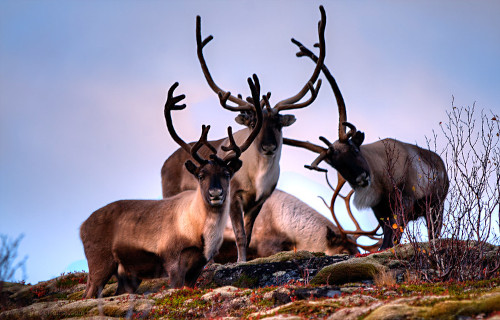
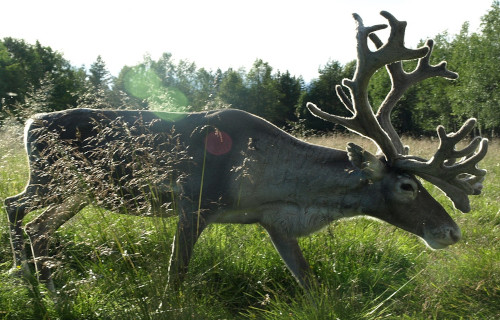
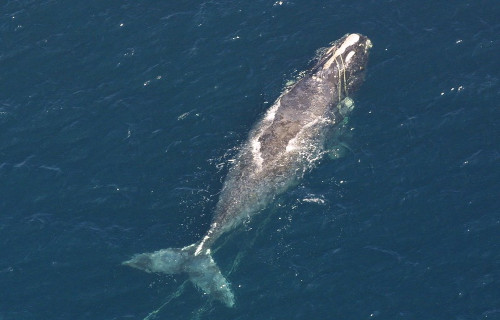
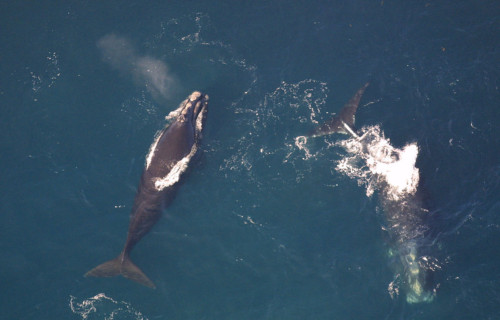
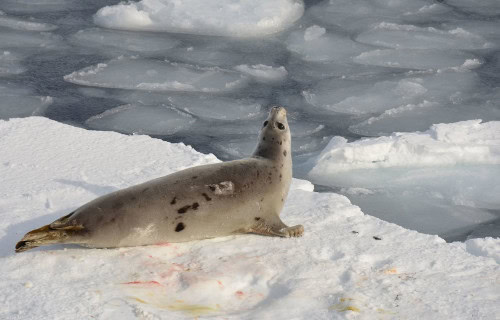
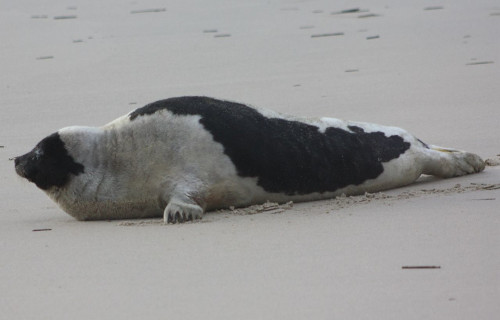
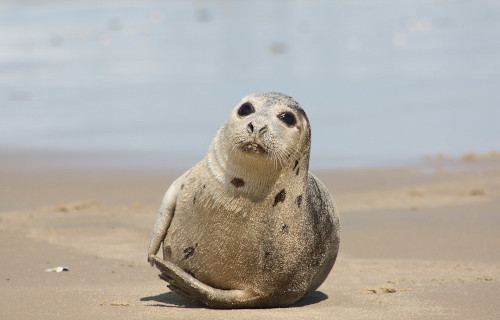









Leave a Reply